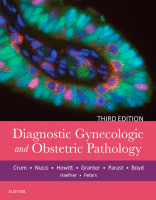Physical Address
304 North Cardinal St.
Dorchester Center, MA 02124

Introduction This chapter addresses the risk factors for pelvic (ovarian and fallopian tube) epithelial cancer, detection, and the role of the pathologist in risk reduction. The 5-year survival for stages IA and IV ovarian cancer are 88% and 18%, respectively,…

Introduction The practice of gynecologic pathology often entails the evaluation of abnormalities in the peritoneal cavity and determination of their relationship to the reproductive tract. This exercise requires that the pathologist distinguish which peritoneal disorders are müllerian derived versus originating…

Introduction To the obstetrician-gynecologist, the ovarian examination is a fundamental part of the gynecologic evaluation and, depending on the age of the patient and other risk factors, ovarian enlargement triggers a series of investigative procedures. The surgical pathologist examines the…

Introduction The fallopian tube comes to the attention of the surgical pathologist under four general scenarios: The tube has been interrupted for sterilization, and the pathologist must confirm this. The tube has been removed as a component of the hysterectomy…

Introduction Definition Uterine mesenchymal tumors are neoplasms derived from or differentiating toward mesodermally derived tissues. Differentiation is typically toward normal constituents of the uterine corpus—endometrial stromal and myometrial smooth muscle cells. However, differentiation toward heterologous tissues—that is, mesenchymal tissue not…

Introduction This chapter addresses endometrial carcinomas, including those with mesenchymal differentiation (carcinosarcomas). Primary endometrial carcinomas constitute a range of morphologies, including carcinomas closely resembling preexisting endometrial epithelium (endometrioid), clear cell carcinomas, uterine serous carcinomas (USCs; also referred to as uterine…

Introduction Endometrial metaplasia is defined as epithelial differentiation that differs from the conventional morphologic appearance of endometrioid epithelium. Altered differentiation would be a better term in that its use would avoid implying that the distinction between metaplasia and neoplasia can…

Introduction The pathways to endometrial cancer are multiple but can be condensed into two major carcinogenic sequences, each with their pathologic correlates. The most established pathway is the one leading to endometrioid carcinoma. This route has a well-defined precursor lesion…

Introduction Pathologists routinely evaluate endometrial biopsies, which account for at least 20% of gynecologic specimens requiring pathology consultation. The majority of endometrial biopsies are performed for abnormal uterine bleeding (AUB) and questions that are posed in each situation requiring biopsy…

Neuroendocrine Carcinoma Historical and Clinical Background Primary neuroendocrine neoplasms in the cervix have been described in various terms in the literature, such as carcinoid tumor, endocrine carcinoma, small cell undifferentiated carcinoma, oat cell carcinoma, and large cell carcinoma. In 1997,…